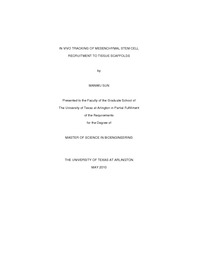
ATTENTION: The works hosted here are being migrated to a new repository that will consolidate resources, improve discoverability, and better show UTA's research impact on the global community. We will update authors as the migration progresses. Please see MavMatrix for more information.
Show simple item record
| dc.contributor.author | Sun, Manwu | en_US |
| dc.date.accessioned | 2010-07-19T19:54:44Z | |
| dc.date.available | 2010-07-19T19:54:44Z | |
| dc.date.issued | 2010-07-19 | |
| dc.date.submitted | January 2010 | en_US |
| dc.identifier.other | DISS-10630 | en_US |
| dc.identifier.uri | http://hdl.handle.net/10106/4906 | |
| dc.description.abstract | The term "Stem cells" has been extensively used to describe precursor undifferentiated cells that have the capacity to self-renew and can also give rise to multiple tissue types. Many studies have been shown improved functional outcome after treated with stem cell therapy. However, almost all of these investigations were analyzed based on histological evaluations which are time-consuming, expensive and fail to provide 3 dimensional and real-time information about stem cell responses. Therefore, there is a need for the development of new method to investigate the migration of stem cells in vivo. Recent evidence supports that fluorescence imaging system offer both near-infrared resolution and whole-body imaging capability.The purpose of this study was to examine whether using in vivo imaging method to track and to identify the localization in vivo of the transplanted stem cells to the site of injury after different routes (IP/ IV) of injection at different time points. Taking advantage of recent progress of whole-body imaging system, bone marrow derived mesenchymal stem cells were labeled with near-infrared imaging agents. Following transplantation, the migration of mesenchymal stem cells was monitored in real-time. To study whether the localized release of chemokines affect stem cell recruitment, scaffolds capable of releasing stromal cell derived-1 alpha (SDF-1α) or Erythropoietin (EPO) were fabricated. Our results have supported our hypothesis that the release of both chemokines enhances stem cell recruitment using whole-body imaging system. Such observations are also confirmed by histological results. The results of this work have lead to the establishment of an imaging system which allows real-time stem cell responses to tissue scaffold implants in animals. | en_US |
| dc.description.sponsorship | Tang, Liping | en_US |
| dc.language.iso | EN | en_US |
| dc.publisher | Biomedical Engineering | en_US |
| dc.title | In Vivo Tracking Of Mesenchymal Stem Cell Recruitment To Tissue Scaffolds | en_US |
| dc.type | M.S. | en_US |
| dc.contributor.committeeChair | Tang, Liping | en_US |
| dc.degree.department | Biomedical Engineering | en_US |
| dc.degree.discipline | Biomedical Engineering | en_US |
| dc.degree.grantor | University of Texas at Arlington | en_US |
| dc.degree.level | masters | en_US |
| dc.degree.name | M.S. | en_US |
| dc.identifier.externalLink | https://www.uta.edu/ra/real/editprofile.php?onlyview=1&pid=58 | |
| dc.identifier.externalLinkDescription | Link to Research Profiles | |
Files in this item
- Name:
- Sun_uta_2502M_10630.pdf
- Size:
- 1.112Mb
- Format:
- PDF
This item appears in the following Collection(s)
Show simple item record


